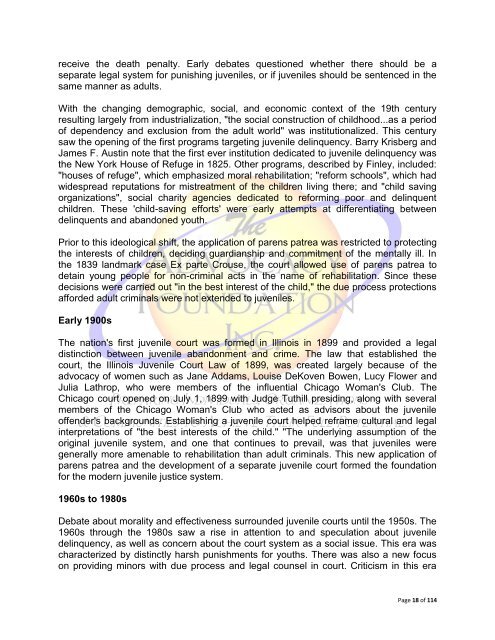African-American Youth in The Juvenile Justice System
African-American Youth in The Juvenile Justice System
African-American Youth in The Juvenile Justice System
You also want an ePaper? Increase the reach of your titles
YUMPU automatically turns print PDFs into web optimized ePapers that Google loves.
eceive the death penalty. Early debates questioned whether there should be a<br />
separate legal system for punish<strong>in</strong>g juveniles, or if juveniles should be sentenced <strong>in</strong> the<br />
same manner as adults.<br />
With the chang<strong>in</strong>g demographic, social, and economic context of the 19th century<br />
result<strong>in</strong>g largely from <strong>in</strong>dustrialization, "the social construction of childhood...as a period<br />
of dependency and exclusion from the adult world" was <strong>in</strong>stitutionalized. This century<br />
saw the open<strong>in</strong>g of the first programs target<strong>in</strong>g juvenile del<strong>in</strong>quency. Barry Krisberg and<br />
James F. Aust<strong>in</strong> note that the first ever <strong>in</strong>stitution dedicated to juvenile del<strong>in</strong>quency was<br />
the New York House of Refuge <strong>in</strong> 1825. Other programs, described by F<strong>in</strong>ley, <strong>in</strong>cluded:<br />
"houses of refuge", which emphasized moral rehabilitation; "reform schools", which had<br />
widespread reputations for mistreatment of the children liv<strong>in</strong>g there; and "child sav<strong>in</strong>g<br />
organizations", social charity agencies dedicated to reform<strong>in</strong>g poor and del<strong>in</strong>quent<br />
children. <strong>The</strong>se 'child-sav<strong>in</strong>g efforts' were early attempts at differentiat<strong>in</strong>g between<br />
del<strong>in</strong>quents and abandoned youth.<br />
Prior to this ideological shift, the application of parens patrea was restricted to protect<strong>in</strong>g<br />
the <strong>in</strong>terests of children, decid<strong>in</strong>g guardianship and commitment of the mentally ill. In<br />
the 1839 landmark case Ex parte Crouse, the court allowed use of parens patrea to<br />
deta<strong>in</strong> young people for non-crim<strong>in</strong>al acts <strong>in</strong> the name of rehabilitation. S<strong>in</strong>ce these<br />
decisions were carried out "<strong>in</strong> the best <strong>in</strong>terest of the child," the due process protections<br />
afforded adult crim<strong>in</strong>als were not extended to juveniles.<br />
Early 1900s<br />
<strong>The</strong> nation's first juvenile court was formed <strong>in</strong> Ill<strong>in</strong>ois <strong>in</strong> 1899 and provided a legal<br />
dist<strong>in</strong>ction between juvenile abandonment and crime. <strong>The</strong> law that established the<br />
court, the Ill<strong>in</strong>ois <strong>Juvenile</strong> Court Law of 1899, was created largely because of the<br />
advocacy of women such as Jane Addams, Louise DeKoven Bowen, Lucy Flower and<br />
Julia Lathrop, who were members of the <strong>in</strong>fluential Chicago Woman's Club. <strong>The</strong><br />
Chicago court opened on July 1, 1899 with Judge Tuthill presid<strong>in</strong>g, along with several<br />
members of the Chicago Woman's Club who acted as advisors about the juvenile<br />
offender's backgrounds. Establish<strong>in</strong>g a juvenile court helped reframe cultural and legal<br />
<strong>in</strong>terpretations of "the best <strong>in</strong>terests of the child." "<strong>The</strong> underly<strong>in</strong>g assumption of the<br />
orig<strong>in</strong>al juvenile system, and one that cont<strong>in</strong>ues to prevail, was that juveniles were<br />
generally more amenable to rehabilitation than adult crim<strong>in</strong>als. This new application of<br />
parens patrea and the development of a separate juvenile court formed the foundation<br />
for the modern juvenile justice system.<br />
1960s to 1980s<br />
Debate about morality and effectiveness surrounded juvenile courts until the 1950s. <strong>The</strong><br />
1960s through the 1980s saw a rise <strong>in</strong> attention to and speculation about juvenile<br />
del<strong>in</strong>quency, as well as concern about the court system as a social issue. This era was<br />
characterized by dist<strong>in</strong>ctly harsh punishments for youths. <strong>The</strong>re was also a new focus<br />
on provid<strong>in</strong>g m<strong>in</strong>ors with due process and legal counsel <strong>in</strong> court. Criticism <strong>in</strong> this era<br />
Page 18 of 114

















